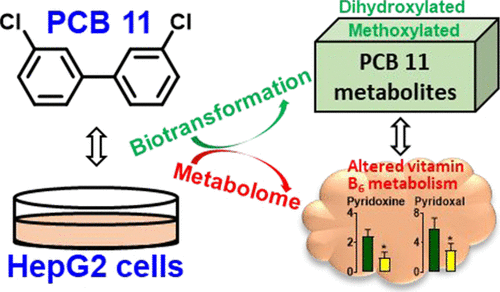当前位置:
X-MOL 学术
›
Environ. Sci. Technol.
›
论文详情
Our official English website, www.x-mol.net, welcomes your feedback! (Note: you will need to create a separate account there.)
3,3'-Dichlorobiphenyl Is Metabolized to a Complex Mixture of Oxidative Metabolites, Including Novel Methoxylated Metabolites, by HepG2 Cells.
Environmental Science & Technology ( IF 11.4 ) Pub Date : 2020-09-10 , DOI: 10.1021/acs.est.0c03476 Chun-Yun Zhang 1 , Susanne Flor 1 , Patricia Ruiz 2 , Ram Dhakal 1 , Xin Hu 3 , Lynn M Teesch 4 , Gabriele Ludewig 1 , Hans-Joachim Lehmler 1
Environmental Science & Technology ( IF 11.4 ) Pub Date : 2020-09-10 , DOI: 10.1021/acs.est.0c03476 Chun-Yun Zhang 1 , Susanne Flor 1 , Patricia Ruiz 2 , Ram Dhakal 1 , Xin Hu 3 , Lynn M Teesch 4 , Gabriele Ludewig 1 , Hans-Joachim Lehmler 1
Affiliation

|
3,3′-Dichlorobiphenyl (PCB 11) is a byproduct of industrial processes and detected in environmental samples. PCB 11 and its metabolites are present in human serum, and emerging evidence demonstrates that PCB 11 is a developmental neurotoxicant. However, little is known about the metabolism of PCB 11 in humans. Here, we investigated the metabolism of PCB 11 and the associated metabolomics changes in HepG2 cells using untargeted high-resolution mass spectrometry. HepG2 cells were exposed for 24 h to PCB 11 in DMSO or DMSO alone. Cell culture media were analyzed with ultra-high-performance liquid chromatography coupled with high-resolution mass spectrometry. Thirty different metabolites were formed by HepG2 cells exposed to 10 μM PCB 11, including monohydroxylated, dihydroxylated, methoxylated-hydroxylated, and methoxylated-dihydroxylated metabolites and the corresponding sulfo and glucuronide conjugates. The methoxylated PCB metabolites were observed for the first time in a human-relevant model. 4-OH-PCB 11 (3,3′-dichlorobiphenyl-4-ol) and the corresponding catechol metabolite, 4,5-di-OH-PCB 11 (3′,5-dichloro-3,4-dihydroxybiphenyl), were unambiguously identified based on liquid and gas chromatographic analyses. PCB 11 also altered several metabolic pathways, in particular vitamin B6 metabolism. These results demonstrate that complex PCB 11 metabolite profiles are formed in HepG2 cells that warrant further toxicological investigation, particularly since catechol metabolites are likely reactive and toxic.
中文翻译:

3,3'-二氯联苯被 HepG2 细胞代谢为氧化代谢物的复杂混合物,包括新型甲氧基化代谢物。
3,3'-二氯联苯 (PCB 11) 是工业过程的副产品,在环境样品中检测到。PCB 11 及其代谢物存在于人血清中,新的证据表明 PCB 11 是一种发育神经毒物。然而,人们对 PCB 11 在人体中的代谢知之甚少。在这里,我们使用非靶向高分辨率质谱研究了 HepG2 细胞中 PCB 11 的代谢以及相关的代谢组学变化。HepG2 细胞暴露于含 PCB 11 的 DMSO 或单独的 DMSO 中 24 小时。采用超高效液相色谱结合高分辨率质谱分析细胞培养基。暴露于 10 μM PCB 11 的 HepG2 细胞形成了 30 种不同的代谢物,包括单羟基化、二羟基化、甲氧基化-羟基化和甲氧基化-二羟基化代谢物以及相应的磺基和葡萄糖醛酸结合物。首次在人体相关模型中观察到甲氧基化 PCB 代谢物。4-OH-PCB 11(3,3'-二氯联苯-4-醇)和相应的儿茶酚代谢物 4,5-二-OH-PCB 11(3',5-二氯-3,4-二羟基联苯)根据液相色谱和气相色谱分析明确鉴定。PCB 11 还改变了多种代谢途径,特别是维生素 B 6代谢。这些结果表明,HepG2 细胞中形成了复杂的 PCB 11 代谢物谱,需要进一步的毒理学研究,特别是因为儿茶酚代谢物可能具有反应性和毒性。
更新日期:2020-10-06
中文翻译:

3,3'-二氯联苯被 HepG2 细胞代谢为氧化代谢物的复杂混合物,包括新型甲氧基化代谢物。
3,3'-二氯联苯 (PCB 11) 是工业过程的副产品,在环境样品中检测到。PCB 11 及其代谢物存在于人血清中,新的证据表明 PCB 11 是一种发育神经毒物。然而,人们对 PCB 11 在人体中的代谢知之甚少。在这里,我们使用非靶向高分辨率质谱研究了 HepG2 细胞中 PCB 11 的代谢以及相关的代谢组学变化。HepG2 细胞暴露于含 PCB 11 的 DMSO 或单独的 DMSO 中 24 小时。采用超高效液相色谱结合高分辨率质谱分析细胞培养基。暴露于 10 μM PCB 11 的 HepG2 细胞形成了 30 种不同的代谢物,包括单羟基化、二羟基化、甲氧基化-羟基化和甲氧基化-二羟基化代谢物以及相应的磺基和葡萄糖醛酸结合物。首次在人体相关模型中观察到甲氧基化 PCB 代谢物。4-OH-PCB 11(3,3'-二氯联苯-4-醇)和相应的儿茶酚代谢物 4,5-二-OH-PCB 11(3',5-二氯-3,4-二羟基联苯)根据液相色谱和气相色谱分析明确鉴定。PCB 11 还改变了多种代谢途径,特别是维生素 B 6代谢。这些结果表明,HepG2 细胞中形成了复杂的 PCB 11 代谢物谱,需要进一步的毒理学研究,特别是因为儿茶酚代谢物可能具有反应性和毒性。



























 京公网安备 11010802027423号
京公网安备 11010802027423号